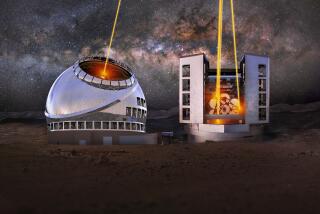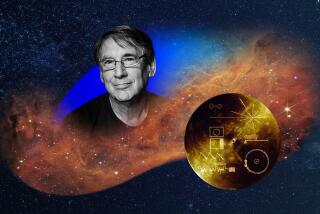Map Project Will Shrink Universe to a Drawer
PRINCETON, N.J. â Sometime in the next 10 years, Jim Gunn plans on putting the universe in a desk drawer.
An astronomer at Princeton University, Gunn supplies the smarts and designs the gizmos for the Digital Sky Survey, the biggest and most comprehensive road map of the universe ever attempted.
Eventually, astronomers will map about 1 million galaxies--the universe has at least 250 million--as well as 100,000 quasars, extraordinarily bright objects whose light streams from the dawn of the universe, 10 billion to 20 billion years ago.
Gunn expects that the map will fit on about 100 laser disks, similar to stereo compact disks, though computer technology may change in the coming decade.
âSo the whole idea is to have this universe that you could put in a desk drawer,â Gunn said in an interview in his cluttered office, where posters of Verdi operas hang next to stellar-galactic graphs. âWeâd like to do it cheaply enough so that every working professional astronomer can have a copy.â
At a cost of $20 million, including $15 million to build a telescope, it is cheap when compared to multibillion-dollar projects such as the Hubble telescope or the Superconducting Super Collider.
Gunnâs father, an itinerant oil prospector in Texas, gave him his first astronomy book--âThe Stars for Samâ--at the age of 7. Gunn next devoured a college textbook on astronomy, and before he was 8 he built his first telescope with his fatherâs help.
Gunn never outgrew his boyhood fascination.
In the world of astronomy, as chronicled in Richard Prestonâs âFirst Light,â heâs known as a master gadgeteer--equal parts tinker and theorist, a cosmologist as comfortable theorizing about quarks as soldering the innards of a recalcitrant telescope.
One noted Gunn creation is his â4-Shooter,â a special scanning camera that helps the giant 200-inch Hale telescope in California peer into deep space.
Hermetically sealed in a gold canister at the heart of the 4-Shooter are four charged-coupling devices, tiny solid-state television cameras often found in spy satellites.
The parsimonious Gunn improvised the rest of the camera from less costly items: junk motors bought on the cheap, piano wire, movie projector belts and a broken razor blade. When strapped to the Hale, it can see a lit cigarette 700 miles away.
Gunn put his work with the Hale to use designing the Sky Surveyâs 100-inch âsmartâ telescope, which will perch atop the Sacramento Mountains in New Mexico.
Light in the form of photons from those million galaxies will fall on a Gunn-designed camera whose 30 charged-coupling devices convert the light to electrical signals.
Special software will analyze the data, sort the celestial objects into galaxies, stars and quasars and produce a two-dimensional map. By feeding the data through special optical fibers, scientists will enjoy a spectrograph of each object.
By reading the spectrographs, scientists can add a third dimension--distance--to each object, as well as a fourth, its age.
But itâs not all numbers and graphs. Astronomers will be able to pop a laser disk into a video player and pull up pictures of every corner of the universe--far-off quasars and colliding galaxies spinning off streams of stars and clouds of cosmic dust.
Another feature of the Sky Survey telescope is its wide-angle lens.
When the Hale telescope peers into deep space, it captures a tiny portion of the sky--stretch your arm out, and imagine a poppy seed on your thumb.
The wide angle of the new telescope will capture a portion of the sky the size of a silver dollar on an outstretched arm, Gunn said, allowing the entire sky to be panned in a cosmic shake of a lambâs tail--perhaps in a year.
And when done, the map should help scientists with some big questions, like how did the universe come into being?
When exploring the evolution of the universe, astronomers turn their gaze to the farthest objects, whose light emanates from sometime near the Big Bang, the theorized explosive birth of the universe.
Gunn argues that this type of study takes place in a near-vacuum without a solid knowledge of the ânearbyâ universe--comparable to a New Yorker making detailed maps of a faraway village while navigating around New York City with a sketch of the interstate system.
âThe sorry fact is that we know so little about the universe nearby in any complete statistical sense,â Gunn said. âYou will have spent millions and millions of dollars to study these things very far away and you wonât have the comparison data.â
Like a census, the Sky Survey will also give a detailed survey of the heavenâs population.
Scientists compare the universe to a slowly expanding sponge--clusters of galaxies form the sponge, voids of unexplained âdark matterâ make up the holes and the whole work expands like rising dough as galaxies move apart from each other.
Astronomers will use the survey to determine the nature of galaxies, which, like people, differ according to their environment.
For example, the Milky Way is in a relatively sparsely populated corner of the universe. With room to expand, the Milky Way developed long spiral arms.
In more crowded parts of the cosmos, stars are crushed together into egg-shaped and elliptical galaxies.
So, will this map be of use to some future Captain Kirk (of TVâs âStar Trekâ)?
Gunn demurred.
âIâm not prepared to say we will never do it, but itâs going to be a while.â
More to Read
Sign up for Essential California
The most important California stories and recommendations in your inbox every morning.
You may occasionally receive promotional content from the Los Angeles Times.










